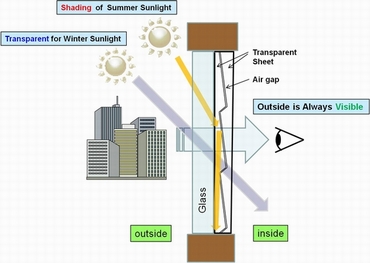November 8, 2013
Energy-Saving Light-Control Film Developed, Automatically Adjusts Sunlight Transmission in Summer and Winter
Keywords: Energy Conservation Environmental Technology University / Research institute
Japan's National Institute of Advanced Industrial Science and Technology (AIST) reported on May 16, 2013, the development of an energy-saving film which automatically obstructs sunlight in summer and transmits it in winter depending on the difference in angle of incident light.
The film is structured to have two concavoconvex transparent sheets align with one another in a complementary manner. Affixing the film to a windowpane maintains the transparent properties of the glass for looking at the outside scenery, just as always, while causing a change between obstructing the light from the high-angle summer sun and transmitting the light from the lower-angle winter sun to occur naturally.
Of the energy consumption of households and workplaces, heating and cooling accounts for about 30 percent. Therefore, simply increasing the insulation of windows has a big energy-saving effect, which has led to the spread of highly-insulated double glazing and low-emissivity glass. Using such light-control films adds insulation and effectively screens radiation from the summer sun, which is expected to reduce air-conditioning loads.



